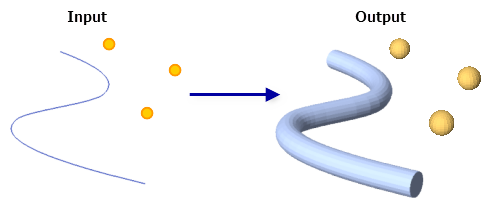| Label | Explanation | Data Type |
Input Features
| The line or point features that will be buffered. | Feature Layer |
Output Feature Class
| The output multipatch containing the 3D buffers. | Feature Class |
Distance
| The radial distance around the input features that will be buffered. Distances can be provided as either a value representing a linear distance or a field from the input features that contains the distance to buffer each feature. If no linear units are specified or are entered as Unknown, the linear unit of the input features' spatial reference will be used. | Linear Unit; Field |
Joint Type (Optional) | Specifies the shape of the buffer between the vertices of the line segments. This parameter is only valid for input line features.
| String |
Buffer Quality
(Optional) | The number of segments that will be used to represent the resulting multipatch features. A higher value produces smoother 3D features but lengthens the processing time. Any number in the range of 6 to 60 can be provided. The default is 20. | Long |
Simplification (Maximum Allowable Offset) (Optional) | Simplifies the input lines by maintaining their shape within the specified offset of its original form. Simplification will not occur if no tolerance value is specified. | Linear Unit |
Summary
Creates a 3D buffer around points or lines to produce spherical or cylindrical multipatch features.
Illustration

Usage
The output of this tool is closed multipatch features that can be used in volumetric computations and other 3D set operator tools.
Consider specifying a Simplification parameter value to improve performance with complex line features, such as curved lines with a large number of vertices.
This tool may not generate a closed multipatch for certain line features if the geometry of the line and the buffer distance produces overlapping regions with dense vertices. As a general rule, avoid buffer distances that may result in the creation of overlapping regions within the same feature.
Parameters
arcpy.ddd.Buffer3D(in_features, out_feature_class, buffer_distance_or_field, {buffer_joint_type}, {buffer_quality}, {simplification_tolerance})| Name | Explanation | Data Type |
in_features | The line or point features that will be buffered. | Feature Layer |
out_feature_class | The output multipatch containing the 3D buffers. | Feature Class |
buffer_distance_or_field | The radial distance around the input features that will be buffered. Distances can be provided as either a value representing a linear distance or a field from the input features that contains the distance to buffer each feature. If no linear units are specified or are entered as Unknown, the linear unit of the input features' spatial reference will be used. | Linear Unit; Field |
buffer_joint_type (Optional) |
Specifies the shape of the buffer between the vertices of the line segments. This parameter is only valid for input line features.
| String |
buffer_quality (Optional) | The number of segments that will be used to represent the resulting multipatch features. A higher value produces smoother 3D features but lengthens the processing time. Any number in the range of 6 to 60 can be provided. The default is 20. | Long |
simplification_tolerance (Optional) | Simplifies the input lines by maintaining their shape within the specified offset of its original form. Simplification will not occur if no tolerance value is specified. | Linear Unit |
Code sample
The following sample demonstrates the use of this tool in the Python window.
arcpy.env.workspace = 'C:/data'
arcpy.Buffer3D_3d('lineFC.shp', 'buffer3d.shp', '15 Meters',
'Round', 30, '1 Meters')The following sample demonstrates the use of this tool in a stand-alone Python script.
'''****************************************************************************
Name: Buffer 3D Example
Description: This script demonstrates an application of
the Buffer 3D and Inside 3D tools.
****************************************************************************'''
# Import system modules
import arcpy
# Set environment settings
arcpy.env.workspace = 'C:/data'
# Set Local Variables
inFC = 'lineFC.shp'
bufferOut = 'buffer3d.shp'
# Execute Buffer 3D
arcpy.Buffer3D_3d(inFC, bufferOut, '15 Meters', 'Round', '30', '1 Meters')
arcpy.Inside3D_3d(bufferOut, 'survey_pts.shp', 'inside_analysis.dbf')